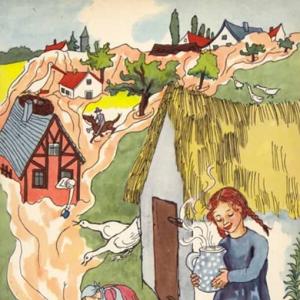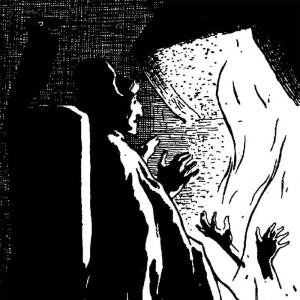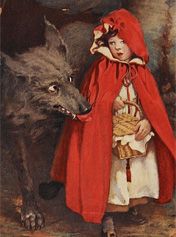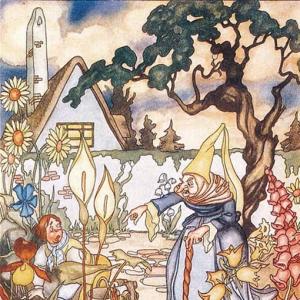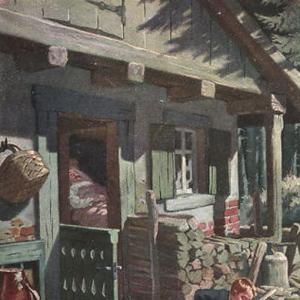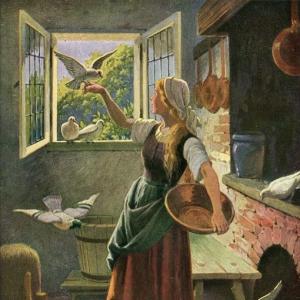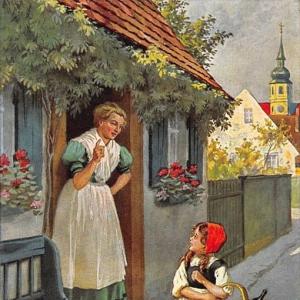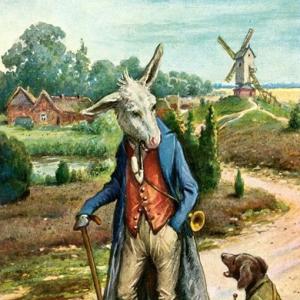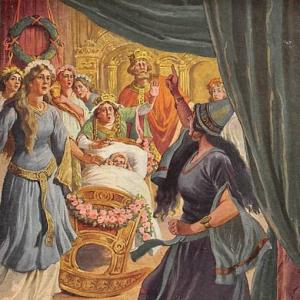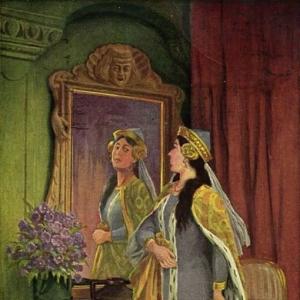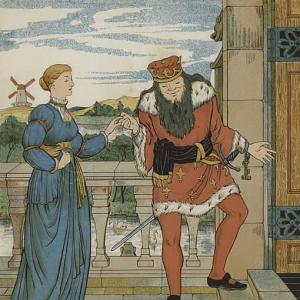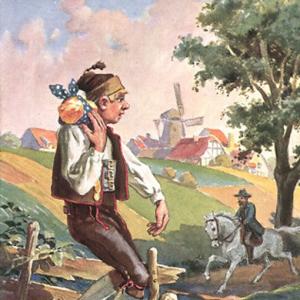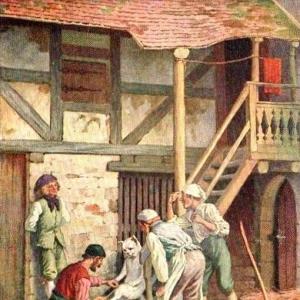Reading time for children: 8 min
A Story Told For My Young American Friends. I’ll tell you a story about luck. All of us know what it is to be lucky. Some know good luck day in, day out. Others only now and then in their lucky seasons; and there are some people who know it only once in a lifetime. But luck comes at some time or other to us all. Now I needn’t tell you what everyone knows, that it’s God who puts little children in their mother’s lap.
Maybe in a nobleman’s castle, maybe in a workingman’s home, or maybe in the open field where the cold wind blows. What you may not know, though it’s just as true, is that when God leaves the child he always leaves it a lucky piece. He doesn’t put this where the child is born, but tucks it away in some odd corner of the earth where we least expect it. Yes, you can rest assured that it always turns up, sooner or later, and that is nice to know.
This lucky piece may turn out to be an apple. That was the case with one man, a scholar called Newton. The apple fell into his lap, and his luck came with it. If you don’t know the story, get someone to tell it to you. I’ve a different story to tell, about a pear. Once there was a man born poor, bred poor, and married without a penny. By the way, he was a turner by trade, but as he made nothing except umbrella handles and umbrella rings, he earned only enough money to live from hand to mouth.
„I’ll never find my luck,“ he used to say. Now this is a Gospel true story. It really happened. I could name the man’s county and his town, but that isn’t important. Wild service berries, with their red, sour fruit, grew around his house and garden as if they were the richest ornament. However, in the garden was also a pear tree. It had never borne fruit. Yet the man’s luck lay hidden in the tree, in the shape of a pear not yet to be seen.
One night the wind blew in a terrible gale. In the next town men said that the great mail coach was lifted from one side of the road to the other as easily as a rag, so it was not to be wondered at that a large branch was torn from the pear tree. The branch was brought into the workshop and, just as a joke, the turner made from it wooden pears, big, little, and middle-sized.
„For once my tree has borne pears,“ he smiled, and gave them to his children for playthings. Among the necessities of life are umbrellas, especially in lands where it rains a lot. But the turner’s family had only one umbrella between them. When the wind blew hard, their umbrella would blow inside out. Sometimes it would break, and luckily the man knew how to mend it. However, with the button and loop that held the umbrella closed, things went from bad to worse.
The button would always fly off just as they thought they had the umbrella neatly folded. One day it popped off, and the turner hunted for it everywhere. In a crack of the floor he came across one of the smallest pears he had given his children for a toy. „If I can’t find the button,“ he said, „I’ll make this do.“ He fitted a string through it, and the little pear buttoned up the umbrella to perfection. It was the best umbrella fastener that ever was seen.
The next time the turner sent umbrella handles and umbrella rings to the city, he added several of the small wooden pears. They were fitted to a few new umbrellas, and put with a thousand others on a ship bound for America. Americans catch on very quickly. They saw that the little pears held better than the other umbrella buttons, and the merchant gave orders that all the umbrellas sent to him henceforth should be fastened with little wooden pears.
There was work for you – thousands of pears to be made for all the umbrellas that went to America. The turner turned them out wholesale, until the whole pear tree was used up making little wooden pears. They brought pennies that grew into dollars. There was no end to the money he made. „My luck was in that pear tree all along,“ the man said. Soon he had a great factory with plenty of workmen to help him. Now that he always had time for joke he would say, „Good luck may lie in a pin.“
And I who tell this story say so too, for it’s a true proverb in Denmark that if you put a white pin in your mouth you’ll be invisible. But it must be the right sort of pin, a lucky piece from God’s own hand. I have one of them, and whenever I come to America, that new world so far away and yet so near me, I’ll always carry that pin. Already my words have gone there.
The ocean rolls toward America, and the wind blows that way. Any day I can be where my stories are read, and perhaps see the glitter of ringing gold – the gold that is best of all, which shines in children’s eyes, or rings from their lips and the lips of their grown-ups. I and in all my friends‘ homes, even though they don’t see me. I have the white pin in my mouth. And luck may lie in a pin.
 Learn languages. Double-tap on a word.Learn languages in context with Childstories.org and Deepl.com.
Learn languages. Double-tap on a word.Learn languages in context with Childstories.org and Deepl.com.Backgrounds
Interpretations
Adaptions
Summary
Linguistics
„Luck may lie in a pin“ is a fairy tale written by Hans Christian Andersen, a renowned Danish author and poet. Born on April 2, 1805, in Odense, Denmark, Andersen is best known for his collection of fairy tales that have been translated into more than 125 languages. Some of his most famous works include „The Little Mermaid,“ „The Ugly Duckling,“ „The Emperor’s New Clothes,“ and „The Snow Queen.“
Andersen’s stories often feature elements of fantasy and folklore and are known for their moral lessons and timeless themes. His tales have captivated readers for generations, providing inspiration for numerous adaptations in literature, theater, and film. In this tale, Andersen weaves a narrative that emphasizes the importance of paying attention to the seemingly insignificant details in life, as they can sometimes lead to fortune and happiness. The story serves as a reminder that luck and happiness can be found in unexpected places and that it is essential to stay open to the opportunities that life presents.
„Luck may lie in a pin“ is a lesser-known tale compared to some of his other works, but it shares many of the qualities that make Andersen’s stories beloved around the world. The tale explores themes of luck, fate, perseverance, and the transformative power of creativity and storytelling. As with many of Andersen’s other fairy tales, „Luck May Lie in a Pin“ likely reflects his own experiences and observations of the world around him, as well as the values and beliefs of 19th-century Danish society.
The background of this story, like many of Andersen’s other tales, is rooted in the oral storytelling tradition of Denmark. Although it is not as widely recognized as some of his other works, „Luck May Lie in a Pin“ shares many of the themes and motifs common to Andersen’s stories, such as the exploration of human nature, the search for happiness, and the role of fate and destiny. Andersen’s fairy tales were written during the 19th century, a time when the industrial revolution was in full swing and social and economic changes were rapidly occurring. His stories often touch upon these changes, addressing the struggles faced by the working class and the importance of personal virtues, such as hard work and creativity, in overcoming adversity.
„Luck may lie in a pin“ is a fairy tale that offers several interpretations and lessons for its readers:
The hidden potential in small things: The story emphasizes that even seemingly insignificant objects, such as a wooden pear or a pin, can lead to great fortune and success. This serves as a reminder to appreciate the potential in small things and not overlook their hidden value.
The role of fate and luck in life: The turner’s life changes dramatically once he discovers the wooden pears, suggesting that luck and fate can play a significant role in our lives. The story encourages readers to remain hopeful and open to the idea that fortune can come from unexpected places.
The power of creativity and innovation: The turner’s inventive use of the wooden pear as an umbrella fastener is a testament to the importance of creativity and innovation in achieving success. By thinking outside the box and repurposing a seemingly ordinary object, he managed to create a product that revolutionized the umbrella industry.
The importance of perseverance and hard work: The turner, despite being born into poverty and facing many challenges, never gave up on his trade. His dedication and persistence eventually paid off when he discovered his hidden fortune. This aspect of the story serves as an inspiration for readers to persevere through difficult times and continue working towards their goals.
The transcendent power of storytelling: Andersen’s tale highlights the ability of stories to connect people across distances and cultures. The author’s stories have reached America, bringing joy and wisdom to countless readers. This theme is a celebration of the universality of stories and their capacity to inspire, entertain, and teach valuable lessons to people of all ages and backgrounds.
Overall, „Luck May Lie in a Pin“ is a thought-provoking tale that invites readers to reflect on the role of chance, fate, and the importance of appreciating the small things in life.
„Luck May Lie in a Pin“ is a lesser-known fairy tale by Hans Christian Andersen, first published in 1859. The story revolves around the idea that luck and happiness can be found in the smallest, most unexpected things in life. Although „Luck May Lie in a Pin“ is not one of Hans Christian Andersen’s most well-known fairy tales, it has still inspired some adaptations and references in various forms of media:
Films and Animations: As with many of Andersen’s stories, „Luck May Lie in a Pin“ has been adapted into short films and animated features, often aimed at a younger audience. These adaptations typically focus on the story’s central themes, such as chance encounters, fate, and the value of seemingly insignificant things. In 1972, a Danish film titled „The Pin“ was released, based on Andersen’s fairy tale. The film was directed by Bent Christensen and starred Ebbe Rode as Ole. In 1979, the Japanese animation studio Nippon Animation produced an animated television series titled „Tales of Hans Christian Andersen“, which included an episode based on „Luck may lie in a pin“.
Literature: The story has been retold and reimagined in various children’s books, sometimes with updated language or illustrations to make it more accessible to modern readers. These retellings often emphasize the moral lessons present in the original tale. In 2015, author William Gay wrote a short story titled „Pin“ that was inspired by Andersen’s fairy tale. The story was published in the collection „Stoneburner and Other Stories“.
Theater: „Luck May Lie in a Pin“ has also found its way onto the stage, with adaptations for children’s theater, puppet shows, or dance performances. These adaptations often simplify the story while preserving its central themes and lessons. Danish artist Vilhelm Pedersen, who collaborated with Andersen on many of his works, created several illustrations for „Luck may lie in a pin“. These illustrations have been reproduced in various editions of Andersen’s fairy tales.
Musical: In 2004, a musical titled „The Pin“ was produced in Denmark. The musical was written by the composer duo Kim Sørensen and Niels Marthinsen and featured lyrics by Sørensen.
Art and illustrations: Various artists have been inspired by „Luck May Lie in a Pin“ and have created illustrations, paintings, or other visual works that capture the story’s essence or depict specific scenes.
The fairy tale „Luck may lie in a pin“ by Hans Christian Andersen has inspired several adaptations in various forms of media. While specific examples may be hard to find due to the story’s lesser-known status, „Luck May Lie in a Pin“ continues to resonate with audiences and inspire adaptations across different media. These adaptations demonstrate the enduring popularity and relevance of Andersen’s timeless fairy tale, which continues to inspire artists and audiences around the world.
„Luck may lie in a pin“ is a fairy tale by Hans Christian Andersen that tells the story of a poor turner who discovers his luck in an unexpected place. The turner, who specializes in making umbrella handles and rings, lives a humble life with his family. They have a pear tree in their garden that never bears fruit, but unbeknownst to them, their luck is hidden within the tree.
One night, a storm breaks a branch from the pear tree. As a joke, the turner crafts wooden pears from the branch and gives them to his children as toys. When the button of their family’s only umbrella breaks, the turner replaces it with one of the small wooden pears. The pear works perfectly as an umbrella fastener, and he sends more of these wooden pears to a merchant in America along with his usual shipment of umbrella handles and rings.
The American merchant recognizes the superiority of the wooden pears as umbrella fasteners and orders more, resulting in a huge demand for the turner’s wooden pears. The turner’s newfound success allows him to open a factory and employ workers, and he realizes that his luck had been in the pear tree all along. He jokes that good luck may lie in a pin, referring to a Danish proverb that says putting a white pin in one’s mouth can make one invisible.
The story emphasizes the idea that luck can be found in the most unexpected places, and that sometimes, a small, seemingly insignificant thing can lead to great fortune. The tale also celebrates the power of stories and their ability to transcend distances, as Andersen’s words and stories have reached America and brought joy to children and adults alike.
The fairy tale „Luck May Lie in a Pin“ by Hans Christian Andersen, although simple in its narrative, can be analyzed from a linguistic perspective to uncover its deeper meanings and stylistic features.
Here are some key aspects that stand out:
Theme and Message
Luck and Providence: The central theme revolves around the concept of luck being a hidden treasure meant for everyone. Andersen suggests that divine providence plays a role in distributing luck, symbolized by the hidden lucky piece placed by God.
Humility and Hard Work: The protagonist, a poor turner, embodies humility and industriousness. His eventual success illustrates the virtue of seizing opportunities and the idea that small, seemingly insignificant things can lead to substantial gains.
Innovation and Adaptation: The man’s innovative use of a wooden pear as an umbrella fastener represents the importance of creativity and adaptability in finding success.
Narrative Style: Andersen employs a conversational and engaging tone, directly addressing his audience („my young American friends“) to establish a connection. This choice makes the tale accessible and relatable.
Symbolism: Objects in the story, such as the pear and the pin, carry symbolic weight. The pear symbolizes unexpected fortune, while the pin suggests a magical element of unseen presence and influence.
Imagery and Metaphors: Andersen uses vivid imagery to paint scenes, such as the violent gale and the whimsical transformation of the pear tree’s branch. These images contribute to the fairy-tale atmosphere.
Proverbial Wisdom: The tale incorporates proverbial sayings, such as „Good luck may lie in a pin,“ reinforcing cultural and moral lessons embedded in the narrative.
Cultural Context
Danish Influence: The mention of a Danish proverb and the idea of luck being a divine blessing reflect Danish cultural attitudes towards fate and providence.
American Aspirations: The story’s connection to America, as seen in the exportation of the pears and Andersen’s allusion to his tales reaching American shores, underscores the 19th-century fascination with America as a land of opportunity.
Conclusion
„Luck May Lie in a Pin“ is a narrative rich with themes of divine providence, the virtue of seizing opportunities, and the wonders of innovation. Andersen’s linguistic choices, from symbolic objects to direct engagement with his audience, enhance the tale’s impact, making it a delightful and thought-provoking story for readers of all ages. The story serves not only as entertainment but also as an allegorical exploration of luck, hard work, and the interconnectedness of seemingly disparate worlds.
Information for scientific analysis
Fairy tale statistics | Value |
|---|---|
| Translations | DE, EN, DA, ES, NL |
| Readability Index by Björnsson | 25.1 |
| Flesch-Reading-Ease Index | 83.7 |
| Flesch–Kincaid Grade-Level | 5.4 |
| Gunning Fog Index | 8.1 |
| Coleman–Liau Index | 7.3 |
| SMOG Index | 8.4 |
| Automated Readability Index | 4.8 |
| Character Count | 4.859 |
| Letter Count | 3.716 |
| Sentence Count | 61 |
| Word Count | 945 |
| Average Words per Sentence | 15,49 |
| Words with more than 6 letters | 91 |
| Percentage of long words | 9.6% |
| Number of Syllables | 1.200 |
| Average Syllables per Word | 1,27 |
| Words with three Syllables | 49 |
| Percentage Words with three Syllables | 5.2% |


